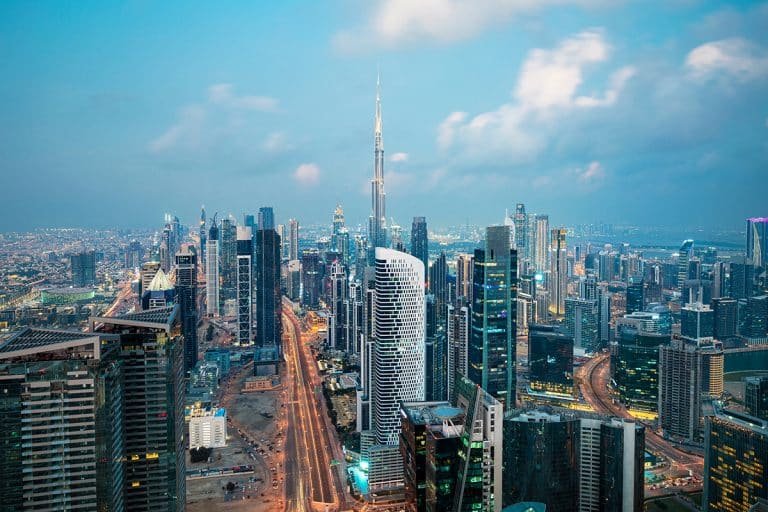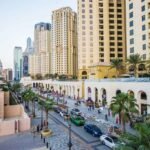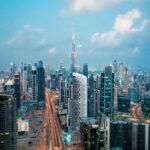Now Reading: Soar Joyfully: Dubai’s Skyline Redefines Glorious Urban Living
-
01
Soar Joyfully: Dubai’s Skyline Redefines Glorious Urban Living
Soar Joyfully: Dubai’s Skyline Redefines Glorious Urban Living
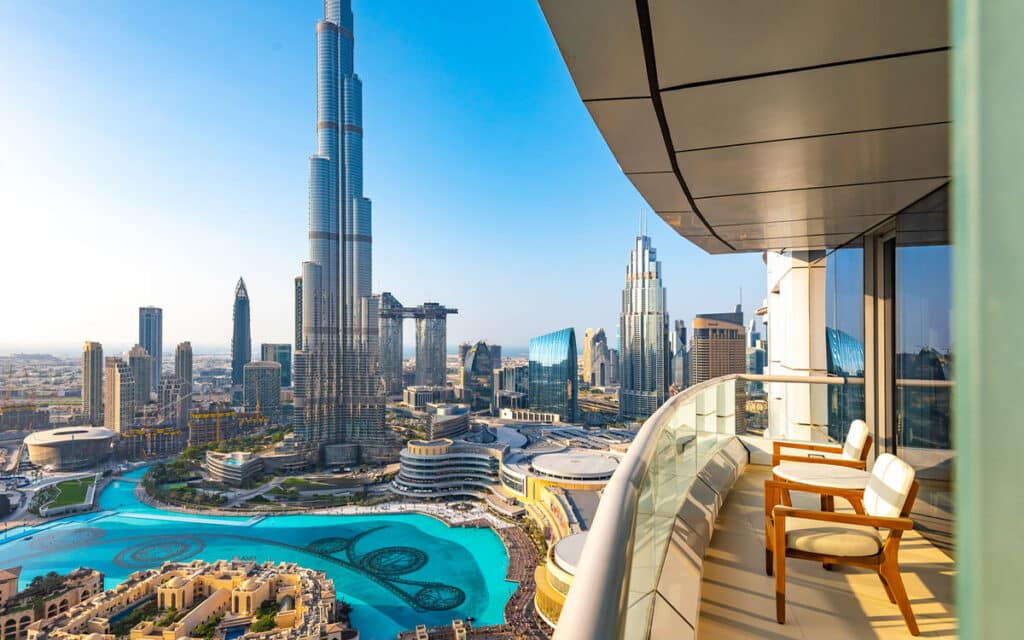
Table of Contents
Imagine stepping onto your balcony, high above Dubai’s shimmering skyline, where futuristic towers blend with vibrant green spaces, and your smart home adjusts the ambiance to match the golden hues of a desert sunset. You sip coffee as drones hum softly overhead, delivering packages, while below, a bustling waterfront hums with life cafés, art installations, and wellness hubs all within reach. In 2025, Dubai’s most anticipated city projects Dubai Creek Harbour, Dubai South, and The Heart of Europe are reshaping the urban skyline with bold architecture, smart technology, and sustainable designs.
These developments are fueling Dubai’s real estate boom, with 96,000 transactions worth $87 billion in the first half, 58% driven by buyers from the UK, India, Russia, and China. Offering 100% freehold ownership, a dirham pegged to the U.S. dollar, and no personal income tax, capital gains tax, or annual property taxes, these properties priced from $1 million to $10 million deliver 6-8% rental yields and 8-12% price appreciation, outpacing London (2-4%) and New York (2-3%).
Properties over $545,000 qualify for a 10-year Golden Visa, while smaller units grant 2-year residency. Powered by 25 million tourists and a 4% population surge, these projects integrate cutting-edge innovation and lifestyle amenities to create urban havens that are as lucrative as they are visionary. Navigating fees, VAT, and 2025 regulations is key to securing your place in these radiant cityscapes.
Redefining the Urban Horizon
Dubai’s 2025 city projects, located 10-30 minutes from Downtown Dubai via Sheikh Zayed or Al Khail Road, are transforming the skyline with iconic structures like the Creek Tower and sustainable hubs like Dubai South. With vacancy rates of 1-3% compared to 7-10% globally, a $2 million Dubai Creek Harbour apartment yields $120,000-$160,000 annually, tax-free, saving $44,400-$72,000 versus the U.S. (37%) or UK (45%). Selling for $2.4 million (20% appreciation) delivers a $400,000 tax-free profit, saving $80,000-$112,000 compared to London (20-28%) or New York (20-37%).
No property taxes save $20,000-$100,000 yearly, unlike London’s council tax (up to 2%) or New York’s property tax (1-2%). Residential purchases skip 5% VAT ($50,000-$500,000), and features like waterfront promenades and sky gardens drive 8-12% price growth. These projects attract global buyers seeking futuristic urban living with unmatched investment potential.
Living here feels like embracing a radiant, soaring metropolis.
Smart Technology Shaping Urban Life
Smart technology is at the heart of these projects, with Dubai South and Dubai Creek Harbour integrating AI-driven homes that control lighting, climate, and security through voice commands or apps. These $1 million-$10 million properties yield $60,000-$600,000 annually, tax-free, saving $22,200-$270,000 compared to taxed markets. Short-term rentals, boosted by 25 million tourists visiting cultural and tech hubs, require a DTCM license ($408-$816), increasing yields by 10-15% ($6,000-$90,000).
Long-term leases, popular with professionals near business districts, need Ejari registration ($54-$136). Non-compliance risks fines up to $13,612, so licensing is critical. Features like drone delivery pads and smart parking systems boost appeal, with 85-90% occupancy rates driven by demand for connected urban lifestyles. A 4% DLD fee ($40,000-$400,000), often split, applies, but zero capital gains tax saves $48,000-$600,000 on $240,000-$3 million profits.
Smart homes feel like a seamless fusion of innovation and comfort.
Sustainable Designs for a Vibrant Future
Sustainability is a cornerstone of Dubai’s 2025 projects, with The Heart of Europe and Dubai South featuring solar-powered buildings, green roofs, and water recycling systems aligned with Dubai’s net-zero goals by 2050. These $1 million-$10 million properties yield $60,000-$600,000 annually, tax-free, saving $22,200-$270,000.
No property taxes save $10,000-$100,000 yearly, and VAT exemptions save $50,000-$500,000 on purchases. Maintenance fees ($10,000-$60,000) cover eco-friendly amenities like urban farms and smart irrigation. Selling a $1 million apartment for $1.2 million yields a $200,000 tax-free profit, saving $40,000-$56,000 versus London or New York. With 8-12% price growth driven by eco-conscious buyers, these projects attract global investors seeking sustainable urban luxury.
Sustainable designs feel like a vibrant step toward a greener skyline.
No Personal Income Tax: Rentals That Thrive
Dubai’s no personal income tax policy lets you keep 100% of rental income, unlike the U.S. (up to 37%) or UK (up to 45%). A $1 million Dubai South apartment yields $60,000-$80,000, saving $22,200-$36,000; a $10 million Heart of Europe villa yields $450,000-$600,000, saving $202,500-$270,000. Short-term rentals, fueled by tourists visiting waterfront or cultural hubs, require a DTCM license ($408-$816), boosting yields by 10-15%.
Long-term leases, ideal for families or executives, need Ejari registration ($54-$136). A 5% municipality fee on rentals ($3,000-$30,000) applies, but non-compliance risks fines up to $13,612. Smart and sustainable amenities enhance rental appeal, driving 85-90% occupancy in 2025.
Tax-free rentals feel like a refreshing wave of prosperity.
Zero Capital Gains Tax: Profits That Soar
Zero capital gains tax lets you keep 100% of sale profits. Selling a $1.5 million Dubai Creek Harbour apartment for $1.8 million yields a $300,000 tax-free profit, saving $60,000-$84,000 versus London (20-28%) or New York (20-37%). A $10 million Heart of Europe villa sold for $12 million delivers a $2 million tax-free gain, saving $400,000-$560,000. With 8-12% price growth driven by urban innovation, these properties outperform global markets, where similar homes rarely exceed $6 million. A 4% DLD fee ($40,000-$400,000), often split, applies, but tax-free profits make these projects wealth-building powerhouses.
Keeping every dirham feels like a radiant financial triumph.
No Annual Property Taxes: Ownership That Feels Light
Unlike global markets, Dubai imposes no annual property taxes, saving $10,000-$100,000 yearly on $1 million-$10 million properties compared to London’s council tax ($20,000-$200,000) or New York’s property tax (1-2%). Maintenance fees ($10,000-$60,000) cover smart systems, green spaces, and 24/7 security, aligning with global luxury standards. A 5% municipality fee on rentals ($3,000-$30,000) is reasonable for these prime locations. These low costs make ownership sustainable, supporting a lifestyle that feels visionary and effortless, perfectly suited to 2025’s urban ambitions.
No property taxes feel like a gentle breeze lifting your investment.
VAT Rules: A Savvy Investor’s Edge
Residential purchases skip 5% VAT, saving $50,000-$500,000 on $1 million-$10 million properties, unlike commercial properties or the UK’s stamp duty (up to 12%, or $120,000-$1.2 million). Off-plan purchases incur 5% VAT on developer fees ($10,000-$100,000), recoverable via Federal Tax Authority (FTA) registration ($500-$1,000).
Short-term rental operators must register for VAT if revenue exceeds $102,041, charging 5% but claiming credits on DTCM fees ($408-$816). A $1 million apartment yielding $60,000-$80,000 incurs $3,000-$4,000 in VAT, with $1,000-$1,500 in credits; a $10 million villa yielding $450,000-$600,000 incurs $22,500-$30,000 in VAT, with $2,000-$3,000 in credits. Non-compliance risks fines up to $13,612, so meticulous records are key.
VAT exemptions feel like a clever boost to your savings.
DLD Fees and Title Deeds: Securing Your Urban Sanctuary
The 4% DLD fee, typically split, applies: $40,000 for a $1 million apartment or $400,000 for a $10 million villa. Gift transfers to family or shareholders reduce DLD to 0.125%, saving $38,750-$387,500. For example, gifting a $10 million villa cuts DLD from $400,000 to $12,500. Title deed issuance costs $136-$272, requiring DLD registration. Broker fees, typically 2% ($20,000-$200,000), may be waived for off-plan projects. Mortgage registration (0.25% of the loan, or $2,500-$25,000) and valuation fees ($680-$1,360) apply for financed deals. The 2025 Oqood system ensures escrow compliance for off-plan purchases, protecting your investment.
Title deeds feel like the key to your visionary urban haven.
Corporate Tax: A Business Buyer’s Note
Introduced in 2023, the 9% corporate tax applies to businesses with profits over $102,110. A company leasing a $1 million apartment yielding $60,000-$80,000 faces a 9% tax ($5,400-$7,200), reducing net income to $54,600-$72,800. A $10 million villa yielding $450,000-$600,000 incurs $40,500-$54,000 in tax. Qualified Free Zone Person (QFZP) status in areas like DMCC avoids this, saving $5,400-$54,000, with setup costs of $2,000-$5,000. Small business relief waives corporate tax for revenues under $816,000 until December 31, 2026. Individual ownership skips this tax, ideal for most investors.
Corporate tax feels like a soft ripple you can navigate.
New Tax Rules for 2025

The Domestic Minimum Top-up Tax (DMTT), effective January 1, 2025, imposes a 15% tax on multinationals with revenues over €750 million ($793 million). Individual investors and smaller entities are unaffected, and QFZP status avoids DMTT, saving $5,400-$90,000. Cabinet Decision No. 34 refines Qualifying Investment Fund (QIF) rules, exempting corporate tax if real estate income is below 10%. A QIF earning $1 million, with $100,000 from rentals, faces 9% tax ($8,100) on 90% ($900,000). A July 2025 policy allows corporate tax deductions on fair market value depreciation, saving $1,818-$18,182 annually for a $1 million apartment revalued at $1.2 million. These rules enhance the appeal of Dubai’s city projects.
New tax rules feel like a puzzle with prosperous solutions.
Top City Projects Transforming the Skyline
1. Dubai Creek Harbour: Waterfront Icon
Dubai Creek Harbour ($1 million-$6 million) offers 6-8% yields and 8-12% price growth, featuring apartments with smart systems and Creek Tower views. A $2 million apartment yields $120,000-$160,000 tax-free, saving $44,400-$72,000. Selling for $2.4 million yields a $400,000 tax-free profit, saving $80,000-$112,000. No property taxes save $20,000-$60,000, and VAT exemption saves $50,000-$300,000. Maintenance fees are $10,000-$40,000, with a 5% municipality fee ($6,000-$8,000). QFZP saves $10,800-$14,400. U.S. investors deduct depreciation ($36,364-$109,091), saving up to $38,182. Its waterfront allure draws UK and Indian buyers.
Dubai Creek Harbour feels like a radiant, urban masterpiece.
2. Dubai South: Aviation and Tech Hub
Dubai South ($1 million-$4 million) offers 6-8% yields and 8-12% price growth, featuring residences with smart energy systems and proximity to Al Maktoum Airport. A $1 million apartment yields $60,000-$80,000 tax-free, saving $22,200-$36,000. Selling for $1.2 million yields a $200,000 tax-free profit, saving $40,000-$56,000. No property taxes save $10,000-$40,000, and VAT exemption saves $50,000-$200,000. Maintenance fees are $10,000-$30,000, with a 5% municipality fee ($3,000-$4,000). QFZP saves $5,400-$7,200. U.S. investors deduct depreciation ($18,182-$72,727), saving up to $25,455. Its tech hub status attracts Chinese and Russian buyers.
Dubai South feels like a vibrant, futuristic retreat.
3. The Heart of Europe: Coastal Urban Vision
The Heart of Europe ($3 million-$10 million) offers 6-8% yields and 8-12% price growth, featuring villas with sustainable designs and resort amenities. A $5 million villa yields $300,000-$400,000 tax-free, saving $111,000-$180,000. Selling for $6 million yields a $1 million tax-free profit, saving $200,000-$280,000. No property taxes save $30,000-$100,000, and VAT exemption saves $150,000-$500,000. Maintenance fees are $20,000-$60,000, with a 5% municipality fee ($15,000-$20,000). QFZP saves $27,000-$36,000. U.S. investors deduct depreciation ($90,909-$181,818), saving up to $63,636. Its coastal vision attracts global elites.
The Heart of Europe feels like a luxurious, eco-urban oasis.
Why These Projects Shine
Price Range: Dubai South ($1 million-$4 million) suits mid-range buyers; Dubai Creek Harbour ($1 million-$6 million) and The Heart of Europe ($3 million-$10 million) target high-end investors.
Rental Yields: 6-8%, with The Heart of Europe at 6-8% for short-term rentals; others at 6-7% for stable leases.
Price Appreciation: 8-12%, driven by urban innovation and sustainability.
Lifestyle: Smart systems, waterfronts, and green spaces create visionary living.
Amenities: Drone pads, sky gardens, and concierges enhance appeal.
ROI Verdict: 8-12% ROI, blending innovation with stellar returns.
Investing here feels like embracing a radiant, urban legacy.
Strategies to Maximize Returns
For individuals: Hold properties personally to avoid corporate taxes, saving $5,400-$54,000. Negotiate DLD fee splits, saving $20,000-$200,000. Use gift transfers to reduce DLD to 0.125%, saving $38,750-$387,500. Recover 5% VAT on developer fees via FTA registration ($500-$1,000). Leverage double taxation treaties with 130+ countries, saving $22,200-$270,000.
U.S. investors deduct depreciation ($18,182-$181,818), saving up to $63,636. For corporates: Secure QFZP status, keep QIF income below 10%, and claim depreciation deductions. Hire property managers ($10,000-$60,000 annually) and tax professionals ($1,000-$3,000) to avoid fines up to $136,125. Focus on short-term rentals in The Heart of Europe, long-term in Dubai South.
These strategies feel like a roadmap to your urban wealth.
Risks to Watch in 2025
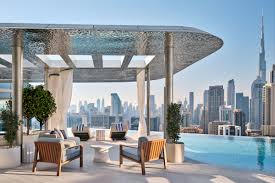
A projected oversupply of 182,000 units by 2026 may slightly slow price growth in newer Dubai South phases, but Dubai Creek Harbour and The Heart of Europe remain resilient due to their iconic status. Off-plan delays risk setbacks, so choose trusted developers like Emaar or Kleindienst and verify escrow compliance via the 2025 Oqood system. Non-compliance with VAT or DTCM rules risks fines up to $13,612, and corporate tax errors can cost $136,125. Indian investors must report properties in India’s Foreign Asset schedule to avoid $135,000 penalties. Currency fluctuations, though minimal with the dollar peg, could impact returns.
Why These City Projects Are Worth It
With 8-12% ROI, 8-12% growth, and tax-free savings of $10,000-$600,000 annually, Dubai’s city projects Dubai Creek Harbour, Dubai South, and The Heart of Europe offer visionary residences, innovative amenities, and global appeal. Golden Visa perks, 85-90% rental occupancy, and a lifestyle blending technology with urban luxury make them 2025 investment gems. Navigate fees, secure your urban haven, and invest in Dubai’s radiant future.
read more: Smart Home Integration Leading Dubai’s 2025 Real Estate Innovations




